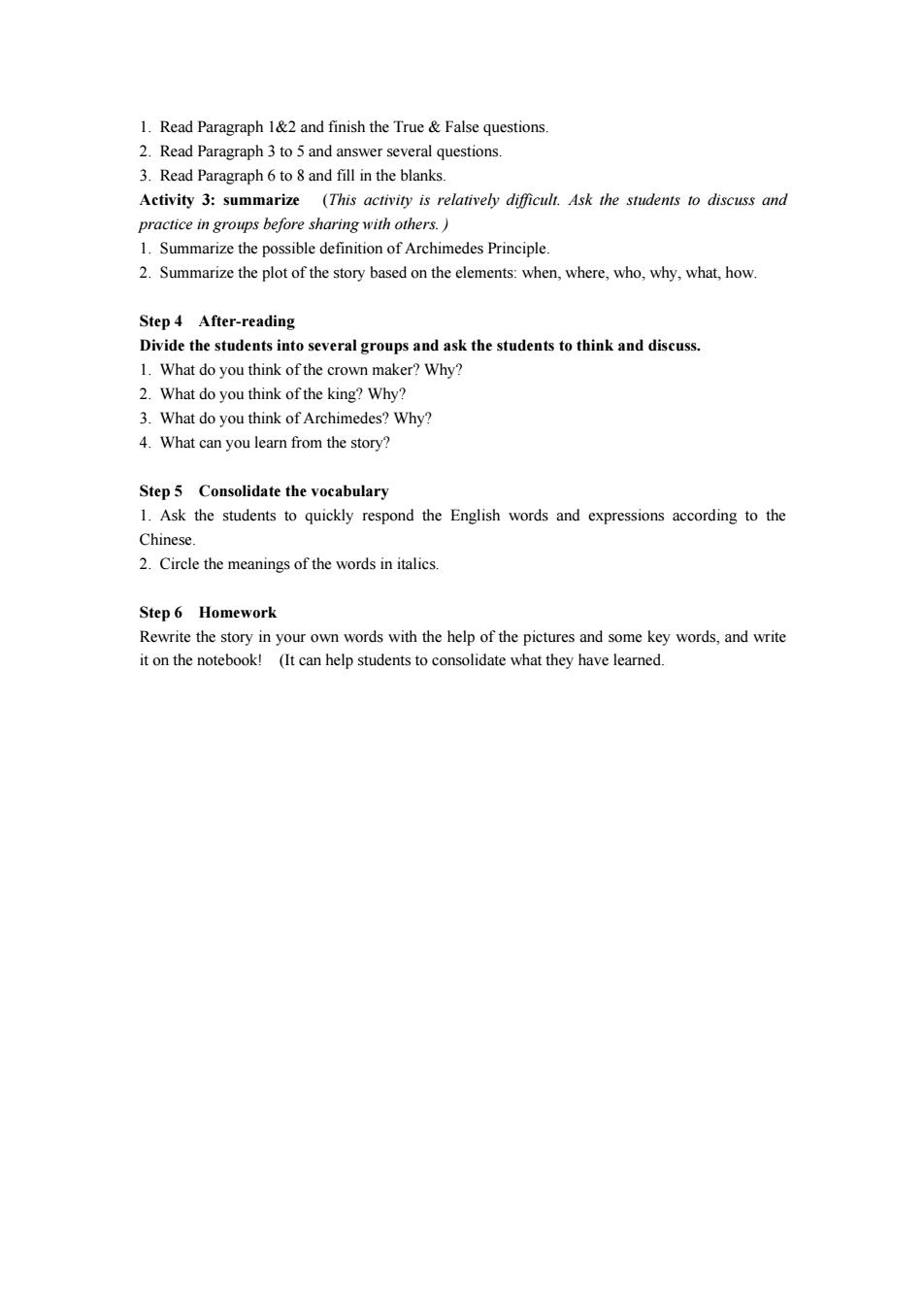
Teaching Design Content: 9AUI Wise men in history Lesson Type: Reading Duration: 20 mins. I.Learning Objectives Knowledge objects: 1.The students master the key words,phrases and language points. 2.The students learn how to retell a story based on the elements of a story:when,where,why,who, how Ability objects: 1.The students develop the ability of reading and thinking. 2.The students'ability of working in pairs can be gradually trained. 3.The students'reading ability can be improved. Emotion or moral objects: 1.The students are inspired to observe the knowledge in life. 2.The students develop an interest in science around. II.Important points and difficult points 1.Students can effectively master the key words,phrases and language points 2.The students learn how to retell a story based on the elements:when,where,why,who,how. III.Teaching Procedure Step 1 Lead-in to arouse the students'interest of this lesson and pre-build some connection with the content. 1.Let students go through the questions and tell the teacher the answer they've found. 2.Ask students whether they know about Theory of leverage. 3.Multiple choices:What do you know about Archimedes? Step 2 Pre-reading (prediction based on some clues like pictures,titles is an important ability, which will make the comprehension easier) 1.Look at the pictures and the title of the story and answer several questions. What is Archimedes doing in the first picture? Why is Archimedes so excited? What is in the right pot in the second picture? Step 3 While-reading Activity 1:Skimming 1.The students will be asked to read the text quickly and put the pictures on page 5 in correct order. Activity 2:Detail reading Ask the students to number the paragraphs first and then read the text carefully part by part
Teaching Design Content: 9AU1 Wise men in history Lesson Type: Reading Duration: 20 mins. I. Learning Objectives Knowledge objects: 1.The students master the key words, phrases and language points. 2.The students learn how to retell a story based on the elements of a story: when, where, why, who, how. Ability objects: 1. The students develop the ability of reading and thinking. 2. The students’ ability of working in pairs can be gradually trained. 3. The students’ reading ability can be improved. Emotion or moral objects: 1. The students are inspired to observe the knowledge in life. 2. The students develop an interest in science around. II. Important points and difficult points 1. Students can effectively master the key words, phrases and language points. 2. The students learn how to retell a story based on the elements: when, where, why, who, how. III.Teaching Procedure Step 1 Lead-in ( to arouse the students’ interest of this lesson and pre-build some connection with the content.) 1. Let students go through the questions and tell the teacher the answer they’ve found. 2. Ask students whether they know about Theory of leverage. 3. Multiple choices: What do you know about Archimedes? Step 2 Pre-reading (prediction based on some clues like pictures, titles is an important ability, which will make the comprehension easier) 1. Look at the pictures and the title of the story and answer several questions. What is Archimedes doing in the first picture? Why is Archimedes so excited? What is in the right pot in the second picture? Step 3 While-reading Activity 1: Skimming 1. The students will be asked to read the text quickly and put the pictures on page 5 in correct order. Activity 2: Detail reading Ask the students to number the paragraphs first and then read the text carefully part by part

1.Read Paragraph 1&2 and finish the True False questions. 2.Read Paragraph 3 to 5 and answer several questions. 3.Read Paragraph 6 to 8 and fill in the blanks. Activity 3:summarize (This activity is relatively difficult.Ask the students to discuss and practice in groups before sharing with others. 1.Summarize the possible definition of Archimedes Principle. 2.Summarize the plot of the story based on the elements:when,where,who,why,what,how. Step 4 After-reading Divide the students into several groups and ask the students to think and discuss. 1.What do you think of the crown maker?Why? 2.What do you think of the king?Why? 3.What do you think of Archimedes?Why? 4.What can you learn from the story? Step 5 Consolidate the vocabulary 1.Ask the students to quickly respond the English words and expressions according to the Chinese. 2.Circle the meanings of the words in italics. Step 6 Homework Rewrite the story in your own words with the help of the pictures and some key words,and write it on the notebook!(It can help students to consolidate what they have learned
1. Read Paragraph 1&2 and finish the True & False questions. 2. Read Paragraph 3 to 5 and answer several questions. 3. Read Paragraph 6 to 8 and fill in the blanks. Activity 3: summarize (This activity is relatively dif icult. Ask the students to discuss and practice in groups before sharing with others. ) 1. Summarize the possible definition of Archimedes Principle. 2. Summarize the plot of the story based on the elements: when, where, who, why, what, how. Step 4 After-reading Divide the students into several groups and ask the students to think and discuss. 1. What do you think of the crown maker? Why? 2. What do you think of the king? Why? 3. What do you think of Archimedes? Why? 4. What can you learn from the story? Step 5 Consolidate the vocabulary 1. Ask the students to quickly respond the English words and expressions according to the Chinese. 2. Circle the meanings of the words in italics. Step 6 Homework Rewrite the story in your own words with the help of the pictures and some key words, and write it on the notebook! (It can help students to consolidate what they have learned